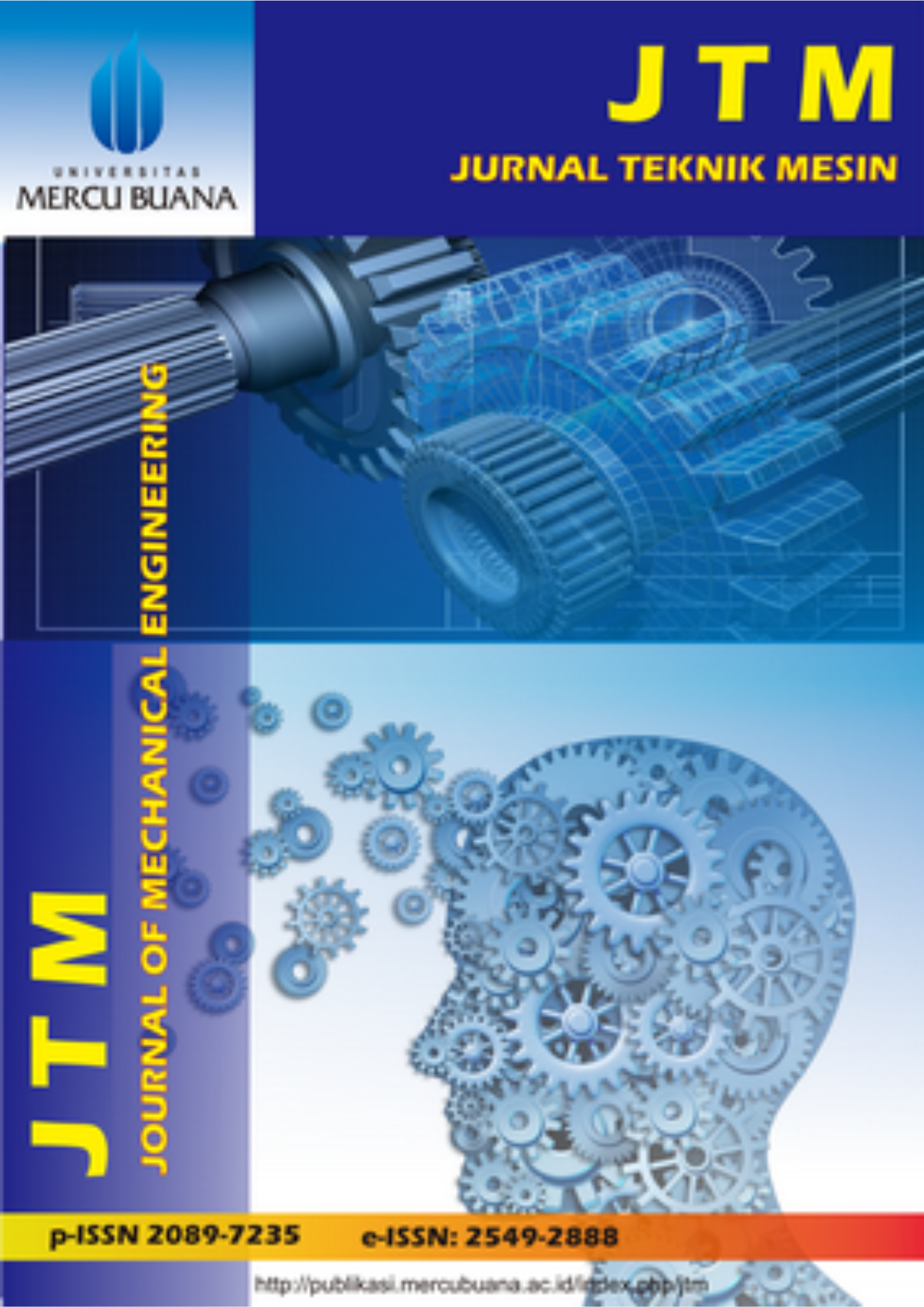STUDY OF THE NEWTON RAPHSON METHOD IN ANALYZING THE DEPTH OF FLUID FLOW IN THE WASTEWATER CANAL U RPS TKRO SMKN 1 CIRUAS USING THE MATLAB APPLICATION
Abstract
Abstract--Flow Depth can be defined as channel height or open channel flow depth, is an important parameter in hydraulic calculations and analysis. The depth of flow in the U channel (U channel) of the Student Practice Room (RPS) for Automotive Light Vehicle Engineering (TKRO) at SMKN 1 Ciruas often causes delayed flow congestion and full channels. Sometimes it is dry if only a few students carry out practical use of room practice and use of water and other waste. The aim of this research is to find a solution to this problem, namely by knowing the depth of flow in the channel so that in the future when designing waste water drainage channels it can be designed appropriately and in accordance with the volume of waste released. The method is to calculate the flow depth in the U channel using NEWTON RAPHSON numerical analysis and the Matlab application to determine the flow depth. The calculation result is the depth of water flow in channel U, with water flow discharge Q = 0.016 m3/s, Manning coefficient for roughness of channel walls and base n = 0.025, slope of channel bottom I = 0.003, and width of channel U B = 0.22 m, at The 11th and 12th iterations flow depth = 0.194864 m. The results of manual exact calculations in the 11th and 12th iterations, the error percentage is 0%, meaning that the flow depth is uniform at a water level of 0.194864 m. Calculations using the Matlab application obtained graphs and the iteration steps were slightly different in the 12th and 13th iterations, the flow depth results were the same = 0.194864 m. The initial guess at flow depth(h)=1, the percentage error is 25%, the uniform flow depth of the RPS TKRO SMKN 1 Ciruas U channel is 0.194864 m.
Keywords : Depth of flow, NEWTON RAPHSON, Open Channel, U Channel, MATLAB
Full Text:
PDFReferences
Sahid, “Analisis dan Implementasi Metode Newton - Raphson Sahid,” no. January 2002, pp. 0–19, 2018.
O. B. Prismayuda, A. Purnama, and D. Najimuddin, “Analisis Distribusi Kecepatan Pada Saluran Terbuka (Study Kasus : Sungai Pelat, Desa Pelat),” J. SainTekA, vol. 1, no. 1, pp. 1–10, 2020.
D. A. Widayanti, “Analisis Hubungan Kecepatan Rerata Terhadap Kecepatan Permukaan Untuk Penentuan Kekasaran Dasar Pada Aliran Saluran Terbuka,” REKONSTRUKSI TADULAKO Civ. Eng. J. Res. Dev., pp. 93–98, 2021, doi: 10.22487/renstra.v2i2.260.
M. Syarif, A. R. Yusuf, and B. Badrun, “Analisis Kecepatan Aliran Pada Penampang Saluran Segi Empat Dan Trapesium Di Saluran Induk Bantimurung Kabupaten Maros,” J. Penelit. Tek. Sipil Konsolidasi, vol. 1, no. 2, pp. 107–111, 2023, doi: 10.56326/jptsk.v1i2.3025.
H. Rohmanto, K. Sawito, H. Siregar, and M. Tantular Jakarta, “Analisis Pola Aliran Saluran Terbuka Dengan Hambatan Persegi Panjang, Bulat, Segitiga, Dan Wing,” Semin. Nas. Ketekniksipilan, Infrastruktur dan Ind. Jasa Konstr., vol. 1, no. 1, p. 2021, 2021.
K. T. P. Raharjo, G. S. Mada, E. B. S. Delvion, Y. P. E. S. Agu, O. R. Sikas, and V. Seko, “Application of Numerical Newton-Raphson Method in Calculation of Emitter Water Discharge of Drip Irrigation System in ‘Mutis Cemerlang’ Coffee Plantation,” JTAM (Jurnal Teor. dan Apl. Mat., vol. 7, no. 3, p. 726, 2023, doi: 10.31764/jtam.v7i3.14947.
W. M. Yanti Jannah et al., “Cara Mudah Menentukan Debit Stabil Pada Saluran Terbuka Dengan Metode Sni 8137-2015,” J. Spektran, vol. 10, no. 2, p. 70, 2022, doi: 10.24843/spektran.2022.v10.i02.p02.
H. A. Abbas, T. A. A. Musa, and A. J. Jihad, “Optimum hydraulic investigation of pipe aqueduct by MATLAB software and Newton-Raphson method,” Open Eng., vol. 12, no. 1, pp. 808–816, 2022, doi: 10.1515/eng-2022-0369.
O. K. Askari Ali, “A Model for Calculating the Rate of Seepage and Irrigation Channel Transition Efficiency,” Am. Univ. Dubai, vol. 23529, no. 2, pp. 1–45, 2018.
P. Sharma, N. Batish, S. Khan, and S. Arya, “Power flow analysis for IEEE 30 bus distribution system,” WSEAS Trans. Power Syst., vol. 13, pp. 48–59, 2018.
V. V. Mehtre, “Review on Newton Raphson Method,” Int. J. Res. Appl. Sci. Eng. Technol., vol. 7, no. 11, pp. 669–671, 2019, doi: 10.22214/ijraset.2019.11107.
G. A. N. Z. Hong, “THERMAL ANALYSIS OF NON-NEWTONIAN FLUID FLOW OVER SUPERHYDROPHOBIC By :,” 2019.
T. H. Hasan and S. H. Chowdhury, “TAYLOR-NEWTON HOMOTOPY METHOD FOR COMPUTING THE DEPTH,” vol. 1, no. February, pp. 2–4, 2010.
I. I. (2017) H Wibowo, S Suripin, RJ Kodoatie, “KOEFISIEN KEKASARAN DASAR MATERIAL NON KOHESIF Abstrak,” 2017.
M. Isnaini and M. S. Dewy, “Pemanfaatan Matlab Simulink Sebagai Media Pembelajaran Praktikum Secara Daring,” J. Teknol. Inf. Komun. Dalam Pendidik., vol. 8, no. 2, p. 169, 2021, doi: 10.24114/jtikp.v8i2.31386.
S. Sukarno, “Struktur Tahanan Aliran Turbulen Di Atas Permukaan Kasar Dasar Saluran Terbuka,” J. Ilm. Media Eng., vol. 3, no. 3, p. 97630, 2013.
S. Hasyim, N. Salam, M. S. Pallu, and F. Maricar, “Studi Kecepatan Aliran pada Saluran Terbuka dengan Dinding Glass Fiber Reinforced Polymer (GFRP),” Pros. Semin. Nas. Tek. Sipil 2023 , pp. 406–414, 2023.
S. Karimi, “Modeling Fluid Flow in an Open Rectangular Channel,” no. September, 2018.
I. M. Galib Ishak et al., “REKAYASA SUNGA UNIVERSITAS TADULAKO Tahun 2020,” 2020.
G. G. Maulana, S. Pancono, and A. Mia, “Desain dan Implementasi Sistem Pengendalian Otomatis untuk Mengatur Debit Air Pada Prototipe Bendung sebagai Pencegahan Banjir,” J. Tek. Inform. dan Sist. Inf., vol. 4, no. 3, pp. 407-421–407–421, 2018.
DOI: http://dx.doi.org/10.22441/jtm.v13i2.27624
Refbacks
- There are currently no refbacks.
Copyright (c) 2024 Jurnal Teknik Mesin
Jurnal Teknik Mesin (JTM)
Program Studi Teknik Mesin, Fakultas Teknik, Universitas Mercu Buana
Jl. Meruya Selatan No. 01, Kembangan, Jakarta Barat 11650, Indonesia
Email: [email protected]
Telp.: 021-5840815/ 021-5840816 (Hunting)
Fax.: 021-5871335
JTM is indexed by the following abstracting and indexing services:

This work is licensed under a Creative Commons Attribution-NonCommercial 4.0 International License.






.png)







_(486_x_90_px)_(486_x_190_px)_(486_x_190_px)_(4).png)
_(486_x_90_px)_(486_x_190_px)_(486_x_190_px)_(5).png)
2.png)
.png)